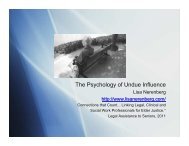Undue Influence: Definitions and Applications - California Courts ...
Undue Influence: Definitions and Applications - California Courts ...
Undue Influence: Definitions and Applications - California Courts ...
Create successful ePaper yourself
Turn your PDF publications into a flip-book with our unique Google optimized e-Paper software.
vulnerability of youths <strong>and</strong> whether there was legal justification for parents’ kidnappings <strong>and</strong><br />
deprogramming of their children (Donohue, 1985). The ACLU concluded that for those who had<br />
reached the age of majority, there was no justification for mental incompetence proceedings,<br />
conservatorships, or temporary guardianships unless physical coercion or its threat had been<br />
used. In the absence of these factors, the ACLU concluded, adult inductees had the right to<br />
exercise their prerogative, <strong>and</strong> it was essentially criminal for “deprogammers” to kidnap cult<br />
members <strong>and</strong> “unbrainwash” them.<br />
Stockholm Syndrome or Traumatic Bonding<br />
The term Stockholm syndrome was coined by criminologist <strong>and</strong> psychiatrist Nils Bejerot,<br />
who assisted police during a 1973 robbery of a bank, the Kreditbanken, in Stockholm, Sweden<br />
(Bejerot, 1974). During the event, the robbers took four bank employees hostage <strong>and</strong> held them<br />
for six days. After their release, the hostages refused to cooperate with law enforcement or to<br />
testify against their captors. They saw law enforcement as the villains, <strong>and</strong> one hostage later<br />
married one of the captors.<br />
Although there is little published academic research on the Stockholm syndrome <strong>and</strong> the<br />
diagnosis is not described in any international classification systems (Namnyak et al., 2007), the<br />
syndrome is acknowledged by prominent law enforcement organizations, including the FBI,<br />
which defines it as a psychological response in which positive bonds develop between hostages<br />
<strong>and</strong> captors. According to the FBI's Hostage Barricade Database System, which contains data on<br />
over 4,700 reported federal, state, <strong>and</strong> local hostage/barricade incidents, 27% of captives show<br />
some evidence of Stockholm syndrome (deFabrique, N.; Romano, S.J.; Vecchi, G.M.; & Van<br />
Hasselt, V.B., 1999).<br />
An FBI directive states that the following conditions are generally believed to be<br />
necessary for the syndrome to occur (deFabrique et al, 1999):<br />
• A person held in captivity cannot escape <strong>and</strong> depends on the hostage taker for life.<br />
• Captors control their captives’ basic needs <strong>and</strong> their lives.<br />
• The hostages are isolated from others <strong>and</strong> have only their captors’ perspectives available. The<br />
captors keep information about the outside world’s response to their actions from captives.<br />
77




